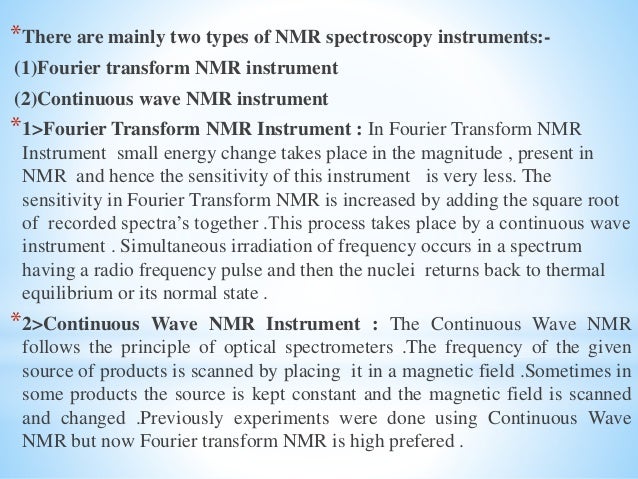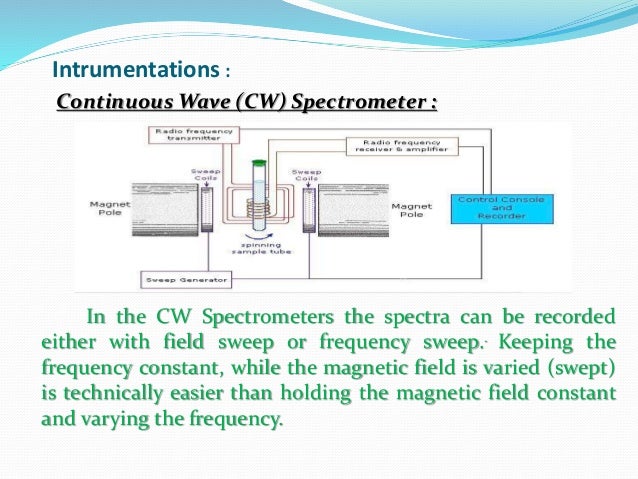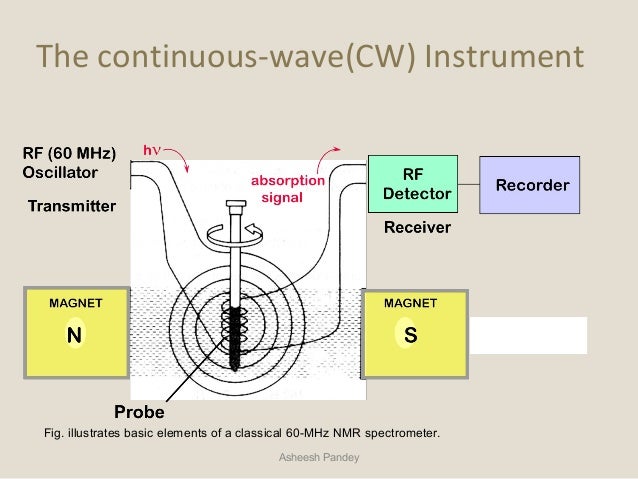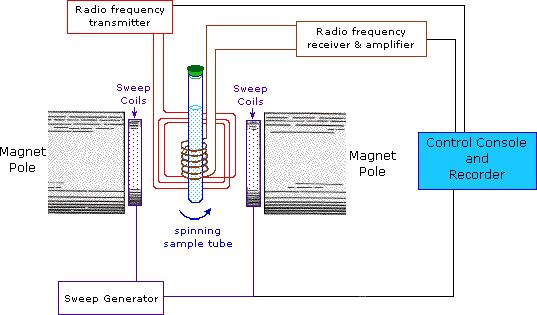IN THIS ARTICLE I DISCUSS ABOUT THE INTRUMENTATION OF NMR.
BASICALLY THERE ARE TWO TYPES OF INSTRUMENT IN NMR
- Continuous wave
- Fourier transform

Early experiments were conducted with continuous wave (CW) instruments, and in 1970
the first Fourier transform (FT) instruments became available. This type now dominates
the market, and currently we know of no commercial CW instruments bing manufactured
at the present time.
NMR spectroscopy was first developed in 1946 by
research groups at Stanford and M.I.T., in the USA. The radar technology developed
during World War II made many of the electronic aspects of the NMR spectrometer
possible.The NMR phenomenon is based on the fact that nuclei of atoms have magnetic properties
that can be utilized to yield chemical information. Quantum mechanically subatomic
particles (protons, neutrons and electrons) have spin. In some atoms (eg 12C, 16O, 32S)
these spins are paired and cancel each other out so that the nucleus of the atom has no
overall spin. However, in many atoms (1
H,13C, 31P, 15N, 19F etc) the nucleus does possess
an overall spin. To determine the spin of a given nucleus one can use the following rules:
- If the number of neutrons and the number of protons are both even, the nucleus has no spin.
- If the number of neutrons plus the number of protons is odd, then the nucleus has a half-integer spin (i.e. 1/2, 3/2, 5/2).
- If the number of neutrons and the number of protons are both odd, then the nucleus has an integer spin (i.e. 1, 2, 3).
Continuous Wave (CW) NMR instruments
Continuous wave NMR spectrometers are similar in principle to optical spectrometers. The sample is held in a strong magnetic field, and the frequency of the source is slowly scanned (in some instruments, the source frequency is held constant, and the field is scanned.

It’s pretty de mode, and is only useful to obtain 1D spectra.The idea behind it is the same as in UV. We scan the
frequencies continuously (or sweep the magnetic field, which
has the same effect - ω = γ B), and record successively how
the different components of Mo generate Mxy at different
frequencies (or magnetic fields).We get a time domain effect in the frequency spectrum (the
famous ringing) because we cannot sweep slow enough.These systems are currently obsolete except for a few
wideline experiments that are performed in specialty solid-state NMR applications.

Fourier Transform (FT) NMR instruments
An alternative approach, common to modern, sophisticated instruments, is to use a powerful but short burst of energy, called a pulse, that excites all of the magnetic nuclei in the molecule simultaneously. In an organic molecule, for instance, all of the 1H nuclei are induced to undergo resonance at the same time. An instrument with a 2.1-Tesla magnetic field uses a short (1- to 10-sec) burst of 90-MHz energy to accomplish this.
The pulse
If a signal of frequency, F, is turned on and then off again very rapidly, then the result is an output consisting of many frequencies centred about F with a bandwidth of 1/t, where t is the duration of the pulse. This means that radiation is produced of all frequencies in the range F ± 1/t. If t is very small, then a large range of frequencies will be produced simultaneously, and all target nuclei in a sample will be excited.

In FT-NMR, all frequencies in a spectrum are irradiated simultaneously with a radio frequency pulse. Following the pulse, the nuclei return to thermal equilibrium. A time domain emission signal is recorded by the instrument as the nuclei relax. A frequency domain spectrum is obtained by Fourier transformation.The magnitude of the energy changes involved in NMR spectroscopy are very small. This
means that, sensitivity can be a limitation when looking at very low concentrations. One
way to increase sensitivity would be to record many spectra, and then add them together.
The effect of applying the pulse
To understand the effect of the radio frequency pulse, consider the precessing nuclei;
• The way every NMR instrument works today.
• We then need something that has all frequencies at once.
A short pulse of radiofrequency has these characteristics.








0 Comments
Thanks for visiting blog. if you have any query please let me know.